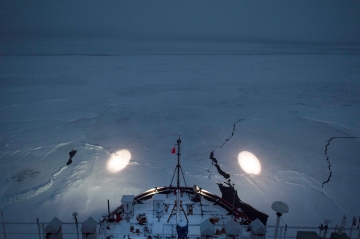701223_Brighter Winters_360 px width_2.jpg

As the climate warms, areas like the Artcic Ocean may experience more ships in the sun-less winters and structures on the coastline due to thinning ice. The light emitted, like that seen here, could impact the vertical migration of zooplankton. Credit: Bhagerty4, CC BY-SA 4.0.
Life in arctic waters is like a giant see-saw. Some species rise to the surface during the day and sink into the depths at night, while others do just the opposite. And the see-saw keeps tottering even during the winter, when there’s no sunlight at all.
But research over the past couple of decades suggests that things could be changing. As the climate warms up, the arctic ice gets thinner. That allows more ships to ply the winter waters. It’s also making it easier to develop the coastline. And all of those ships and buildings are lighting up the night.
A couple of decades ago, scientists discovered that tiny organisms known as zooplankton continue their up-and-down motion even during the winter. The organisms stay active, helping everything else roar back to life in spring and summer.
But the organisms scoot away from artificial light sources. So do fish. Increased light in the years ahead could interrupt the natural rhythm of the ocean, perhaps with dire consequences for all life.
Scientists in Norway are studying the effects of winter lighting through a project called Deep Impact. They’re comparing how marine creatures respond when research vessels are dark versus when they’re well lit. And they’re deploying packages of instruments with nicknames like Fish Disco, which sets off flashes of multi-colored lights.
The research should tell us more about how life in the Arctic Ocean will respond to brighter winter skies—a result of our warming climate.

